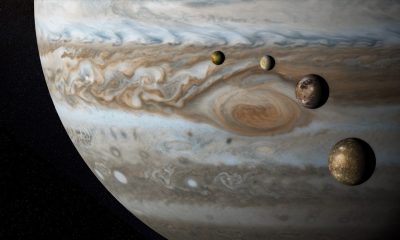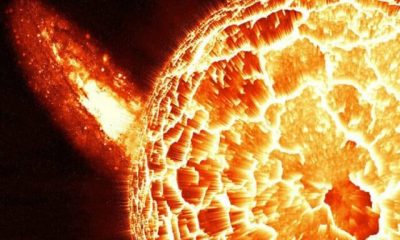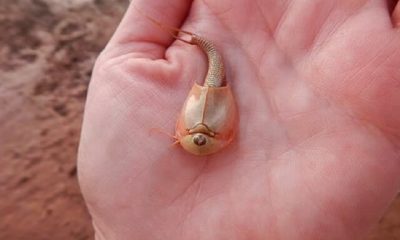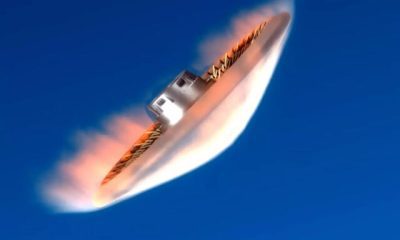Space
Jupiter planet , its features, moons and wonders
Published
1 year agoon


The Jupiter is the largest planet in the solar system, which is highly regarded because of its attractive features such as the Great Red Spot and the mysterious icy moons like Europa and Ganymede.
The Jupiter’s planet, known as Burjis, Hormuz or Jupiter, is the fifth and largest planet in the solar system. The Jupiter has a major role in the transformation of the solar system history, and the earth owes to the Jupiter to some extent.
The planet, along with Saturn, are gas giant. The Jupiter is a combination of hydrogen and helium and because of its high speed of rotation, its shape is not completely spherical. The Jupiter’s external atmosphere is divided into several strips of different latitudes, creating storms, storms, and vortex currents. One of the points of sharing these strips is the famous red spots; A huge storm that was first observed in the seventeenth century with a telescope.
The Jupiter’s planet has a pale ring and a strong magnetosphere. The planet, also called the King of the planets, has four approved moons. The Jupiter ranks second in the solar system in terms of the number of moons and after Saturn (with 2 lunars). The most famous moons on the planet is a four-storey collection known as the Galileo moons that were discovered in the year 6 by Italian scientist Galileo Galileo. ganymede is the largest Jupiter’s moon and the largest moon in the solar system.
Jupiter planet
Robotic spacecraft have done a lot of research on the Jupiter. The most famous Jupiter missions include Woeeiger and Pioneer and then Galileo’s circuit. In late February, the New Huraznesian probe visited the Jupiter and used the planet’s attraction to speed up and be on the Pluto route. The last mission to the Jupiter was carried out by the Juno probe, which was to orbit the planet on July 1.
The titles you will read in this article:
- What is the Symbol of the Planet?
- How was Jupiter Planet formed?
- How many times is Jupiter Earth?
- Physical properties and internal composition of the Jupiter’s planet
- How many moons does the planet have?
- Jupiter loops
- Wonders of Jupiter Planet
- Seeing the Jupiter Planet from Earth
- Jupiter probes
- Future missions to the Jupiter
Ten Interesting Facts About Jupiter Planet
- The Jupiter is the largest planet in the solar system, named after the God of heaven and thunder. The planet is mainly made up of gas (hydrogen and helium) and its inner core is almost the same as Earth.
- The Jupiter’s planet has at least 2 lunars, with four large reds: Io, europa, Ganimid and Calisto (these moons are also known as Galileo’s moons). Although the planet of Jupiter cannot host life, some of its moons have the potential for life because of the oceans below the level of life.
- The rotation of the Jupiter around it is faster than any other planet, and this leads to veins: Dark areas (belts) indicate the rise of clouds and gases; Bright areas (areas) represent a belt session.
- The speed of the Jupiter’s rotation in the equator is fast and in the poles is slow; Thus, the gas layers in the impulse collision areas cause white spots, spiral storms and vortexes. One of the most famous Jupiter storms is the large red spot three times the size of the earth. This is not a constant storm.
- The Jupiter’s planet has four rings. The Vaviger probe discovered these rings in year 2. These rings are very pale and, unlike the transparent rings of Saturn, made up of ice and rock, were made of dust particles.
During his mission, the Juno probe has come to the attractive facts about the planet’s Jupiter:
- The Jupiter’s atmosphere is amazing. According to Juno’s findings, this gas giant is much more turbulent than imagination. The cloud and wind climate is not only seen in the upper layer of the planet. Rather, but these winds also exist in the depths of the Jupiter for thousands of kilometres. Also, surprisingly, Jupiter strips disappear near its poles.
- According to hypotheses, the famous Jupiter’s gas clouds (a combination of water and ammonia) are equally combined. However, there is less ammonia at the surface and most of the ammonia is focused on the nucleus.
- At the north and south poles of the Jupiter, there are circular chains of massive tornadoes. These rotating storms are extremely dense on the continents of the earth. Their length is 2 kilometres and their width is hundreds of kilometres.
- The Jupiter’s solid core at its centre is not completely intensive. Rather, a swollen butter is half the Jupiter’s diameter. No one knows what the reason is, but according to hypotheses, a heavy crime has been treated by the Jupiter, which has made the core with other surrounding gases.
- The Jupiter has the strongest magnetic field in the solar system, but Juno shows that the field is even stronger and closer to the planet’s surface. Also, the north and south poles of the Jupiter are not similar.
What is the Symbol of the Planet?
Jupiter or Jupiter has been known since ancient times. The planet is also known in various cultures by numerous names such as Jupiter (Roman culture), Burjis, Urmd and Zavash. The Jupiter is visible in the night sky with an unarmed eye and sometimes during the day (when the sun is low). The Romans named the planet, inspired by one of the Roman myth gods, Jupiter (also known as the God of love).
The Babylonians knew the Jupiter in the name of their God, Mardok. They used the Jupiter’s 5 -year period alongside the circle to define zodiac constellations. The Romans considered the Jupiter the star. On the other hand, in Greece, the Jupiter was known as Zeus (the counterpart of the Roman God Jupiter). The ancient Greeks knew this planet as a shiny or ignorant star. The origin of the Jupiter’s astronomical symbol (image below) is unclear; But many consider it to be a thunderstorm, and according to new reports, it means eagle based on the Egyptian hieroglyphic line.
How was Jupiter Planet formed?
Jupiter is the oldest planet in the solar system. The planet, which is 1.5 times heavier than the rest of the solar system planets, has played an important role in the formation and evolution of its neighbours. Approximately 1.5 billion years ago, the solar system of gas and dust or solar nebulae was. Gravity collapsed this substance and began to rotate; The sun was created at its centre. With the formation of the sun, the rest of the materials were dense. The small particles with the gravitational force were close to each other and turned into larger particles.
Solar winds removed lighter elements, such as hydrogen and helium, and made stone and heavy materials near the sun making smaller stone worlds like Earth. Since the solar winds had less effect on lighter elements, they joined each other for the formation of gas giants.
According to the core accretion model, the planet’s stone cores initially formed, then formed lighter elements, mantles and shells of planets. In the stone worlds, the lighter elements of the atmosphere formed. The study of external planets (outside the solar system) confirms the theory of nucleus accumulation as the prevailing process. Stars that have more metal in their core (a term used by astronomers for elements other than hydrogen and helium) have larger planets in their system than stars made of metal only.
Disk instability model
The process of core accumulation for gas giants like the Jupiter requires a lot of time. The cloud of matter around the sun only lasts a short time; Either it turns into the planet or completely disappears. Giant planets were formed very quickly and only a few million years. As a result, based on a specific time range, the gas ring around the sun has only lasted 2 to 5 million years.
According to a relatively new theory called disk instability, gas masses and dust were joined early in the Solar System. Over time, these masses became larger planets. The speed of formation of these planets is, based on this theory, faster than the theory of nucleus accumulation, and sometimes even reaches several thousand years. Continuous Jupiter clashes (just like other planets) raised the temperature of the planet. Dense materials to the centre formed the nucleus. Some scientists believe that the core of the planet can be a hot sphere of liquids; However, according to other research, the Jupiter’s core is a solid stone 2 to 5 times the size of the Earth.
Team accumulation
The biggest challenge of nuclear accumulation theory is its time. According to another study, small bodies of pebbles for forming large planets at a speed of 5x faster than previous models joined each other. In year 2, two researchers, Michel Lampbracrt and Anders Johannes, from the University of Land Sweden, presented the theory of small particles. According to them, the remaining pebbles of the formation processes (previously considered trivial) can have the key to the problem of forming planets.
Jupiter relocation
In year 4, scientists unveiled the Grand Tack. According to this theory, the Jupiter had a two-step immigration after forming a two-step migration. Jupiter has formed exactly about 1.5 astronomical units of the sun and is located in the current position of 1.5 astronomical units after a two-step transfer.
During these transfers, the Jupiter is thought to have destroyed many objects, including some planets of the solar system. Without a Jupiter probably there was no earth; This planet has made the way to Earth easier to destroy smaller worlds.
How many times is Jupiter bigger than Earth?
If we combine the mass of the entire planets of the solar system, the Jupiter’s mass will be more than twice. This gas giant can accommodate four planets on Earth. As a result, if you assume Jupiter is the size of a basketball ball, the Earth will be the same as a grape seed. The planet is also 5 times heavier than Earth. In the Jupiter’s diameter, there are four planets Earth.
Physical properties and internal composition of the Jupiter’s planet
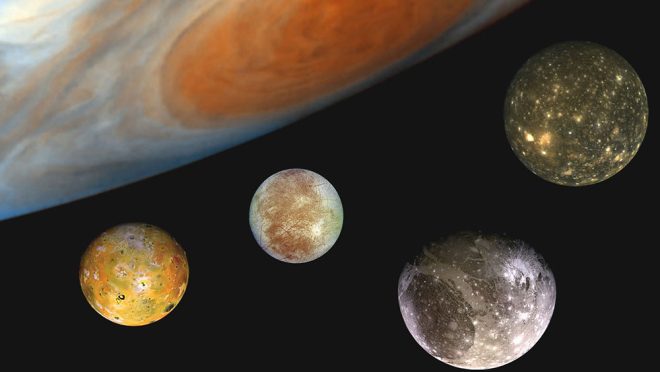

Much of the Jupiter is made up of fluid and gas materials. The diameter of the giant reaches 1.2 kilometres. Its average density is 5 grams per cubic centimetre and is ranked second among gas giants. Much of the Jupiter is made up of gas and liquid materials and denser materials are in the lower layer. 2 to 5 percent of the upper atmosphere of the planet is hydrogen and 2 to 5 percent the helium. Overall, 5 % of the planet’s mass is hydrogen, 2 % of it is helium and the remaining one percent are other elements.
Jupiter’s atmosphere includes methane, water, steam, ammonia and silicone compounds. Carbon, ethane, hydrogen sulfide, neon, oxygen, phosphine and sulfur are also traced. The outermost layer of barley consists of frozen ammonia crystals. Material density is higher in the inner layers.
Using ultraviolet and infrared measurements, benzene and hydrocarbons have also been discovered on the planet. Based on spectroscopy results, the Jupiter’s composition is almost similar to Saturn’s composition; But the other two gas giants, Uranus and Neptune, have less hydrogen and helium than the Jupiter, and are therefore called ice giants.
Jupiter’s planet can accommodate 1300 Earth


According to gravity measurements at 2, the planet’s nucleus mass was estimated at 2 to 5 times more than Earth’s mass. The Jupiter’s core accounts for 2 to 5 percent of its overall mass. Jupiter radius is approximately one-tenth of the sun’s radius and one thousand mass; So the density of both is the same. Jupiter mass is usually used as a unit to describe the mass of other objects, especially external planets or brown dwarfs.
If the Jupiter was heavier, he would have been a hydrogen fusion and would become a star; However, the radius of the smallest red dwarf is only 5 % more Jupiter. However, the Jupiter spreads more heat than the heat received from the sun.
The amount of heat generated by the Jupiter is equal to the total solar radiation received by the planet. This process makes the Jupiter smaller every year. While it was much hotter at the beginning of the formation, its diameter was twice that of its current diameter. According to existing hypotheses, the core of the rocky Jupiter is; But its exact composition is still unknown. The nucleus may be surrounded by concentrated metal hydrogen, which makes up a 2 % radius of the planet. Raindrops, such as helium and neon, precipitate at the bottom of this layer, and the abundance of these elements in the upper atmosphere is minimized.
Climber
Like the sun’s atmosphere, much of the Jupiter’s atmosphere is made up of hydrogen and helium. Dark and light-coloured strips on Jupiter’s atmosphere are created by strong east-west winds that move more than 5 km / h. Clouds in bright areas are a combination of frozen ammonia crystals; While clouds in darker areas are formed more than other chemicals. At the deepest surface of the planet are blue clouds. Jupiter cloud tapes change over time and fall into the client’s atmosphere of diamonds.
It can hardly be said to be exactly what the Jupiter’s atmosphere is formed, as 2 % of the planet is hydrogen and 2 percent is helium. On the ground all of these gases are considered; But the strong Jupiter attraction makes the atmosphere of the planet become a multi-layer, each of which has attractive and unique features. Unlike the Earth, there is no clear boundary between the client’s atmosphere and the planet itself. With more penetration to the client’s depths, the density and temperature of hydrogen and helium change, and scientists describe the different layers of the Jupiter’s atmosphere based on these changes. Jupiter’s atmospheric layers include the troposphere, stratosphere, thermosphere and exhaustion.
Since the Jupiter lacks an integrated surface, scientists estimate the lower part of the atmosphere to be 5 kg; The planet’s atmosphere is exactly above this point. The client’s atmosphere, like the ground, decreases with height until it reaches its minimum value. The minimum amount of atmosphere can be found at the boundary between the troposphere and the stratosphere, the tropopause (approximately 2 kilometres above the Jupiter’s surface).
The stratosphere stretches to a height of 2 kilometres and reduces the pressure in the direction, with a decrease in temperature pressure. At this point, the boundary between the stratosphere and the thermosphere is defined. The thermosphere temperature at a height of 2 kilometres reaches 2 degrees Celsius. All the clouds and storms visible are placed at the bottom of the Jupiter’s troposphere and consist of ammonia, hydrogen sulfide and water.
Jupiter’s large red spots
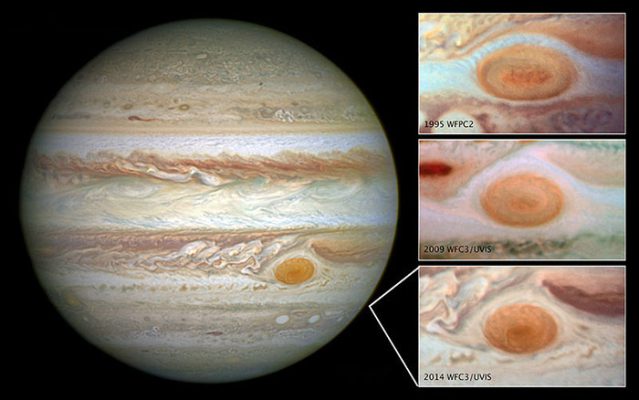

The most prominent feature of the Jupiter is its large red spot. This stain is a steady tornado storm larger than the Earth, located at an angle of the equator, based on one hypothesis of 1 and based on another hypothesis of 2. This stain is large enough to be easily visible with an amateur telescope with a 5cm aperture. To rotate this storm, unlike clockwise and its 4 -day circulation interval. The maximum height of this storm is 2 kilometres above the cloud.
According to mathematical models, this storm is stable and may be one of the sustainable features of the planet. However, the size of this stain has always declined. At the end of the century, the width of the stain was estimated at 2.5 kilometres, four times the diameter of the Earth. After the Voyager spacecraft arrived on the planet in year 2, the storm had doubled to the planet’s width.
Studies of the Jupiter’s red stain show that the size of the stain is still decreasing. On April 1, the width of the stain was estimated at 1.5 kilometres, which is 1.5 times the diameter of the Earth. The longest storm on the earth lasts 2 days, But the Jupiter has more sustainable storms because of the thousands of kilometres of the atmosphere at a much higher speed than the Earth’s rotation.
Jupiter Magnetic Square
The Jupiter’s magnetic field is fourteen times stronger than the Earth’s magnetic field. The field is thought to be created by vortex currents in the planet’s hydrogen core. Some features of the Jupiter’s magnetic field are unique and there are no such as the Earth’s magnetic field.
The Jupiter’s Jupiter’s lunar volcanoes release large quantities of sulfur dioxide, resulting in a gas halo around the orbit. This gas is ionized in the Jupiter’s magnetosphere and released sulfur and oxygen ions.
These ions, along with the Jupiter Hydrogen ion, form a plasma plate in the tropical body of the planet, the plasma on this planet rotates along with this planet, resulting in bipolar magnetic disk deformation to a magnetic disk. The electrons on the plasma plate create a powerful radio effect that produces explosions in the range of 1.2 to 5 MHz.
The Jupiter’s magnetosphere is the cause of the intense spread of radio material from the polar parts of the planet. Ivy’s volcanic activity of the planet leads to the spread of gas in the Jupiter’s magnetosphere and creates a halo of particles around it. As Io moves in this aura, the waves of alpha are created. Alfon wave is a type of hydrodynamic magnetic wave in which the ions fluctuate in response to an effective voltage on the magnetic field lines. These waves carry ionic materials in the polar areas of the Jupiter.
Rotation and Jupiter circuit
The average distance between the Jupiter and the sun is 2 million kilometres (approximately 1.5 times more than the distance between the Earth and the sun), and every 2.5 years rotate around the sun. The elliptical circuit of the Jupiter has a 1.5 -degree deviation compared to the ground. Exit from the centre of the planet’s orbit is 1.5 %, so its distance from the sun between the nearest call (peak) varies by 5 million kilometres.
Read more: How could Big Bang arise from nothing
The pivotal oscillation of this planet is relatively low: 1.5 degrees. As a result, there are not many seasonal changes compared to Earth and Mars. The Jupiter rotates around the planets of the solar system at the highest speed and completes the rotation around its axis in less than ten hours due to the high speed of a tropical protrusion, which is easily visible through an amateur telescope based on the Earth. . The Jupiter’s equator is 5 kilometres more than the diameter of its poles. Because the Jupiter is not a rigid body, its upper atmosphere has a different rotation. The rotation of the Jupiter’s polar atmosphere is approximately 5 minutes longer than its tropical atmosphere.
How many moons does Jupiter planet have?
The Jupiter has 2 approved moons. The Jupiter ranks second in the solar system in terms of the number of moons (with 2 lunars); But according to the latest research, Canadian astronomers found evidence of the existence of four small moons in the Jupiter’s orbit, and according to speculation, the number of moons on the planet could reach 5; But they have not yet reached the approval and observation stage.
Overall, of the 5 -approved Jupiter moon, the four largest Galileo moon is more popular. The moons were discovered independently by Galileo Galileo and Simon Marinus in the year 9. Early in the early days, more of the Jupiter’s moons were discovered and the names of the lovers or girls of Jupiter, the Roman God or Zeus (its Greek counterpart). Galileo moons are the largest and heaviest objects in the Jupiter’s circuit.
Eight Jupiters are from regular moons with almost circular circuits. Galileo’s moons are almost spherical due to a planetary mass. If these moons were in the orbit of the sun, they would be in the category of dwarf planets. The other four are smaller and are less than the Jupiter’s planet; These moons are resources for the formation of Jupiter circles. Other Jupiter moons are irregular and their circuit is far from the Jupiter. These moons are likely to be trapped in the attraction of the solar circuits. Twenty-two irregular Jupiters have not yet been officially named.
Regular Jupiter moons are thought to be formed from the planet’s rotary disk; A ring of gas and stone-like that is similar to the initial planetary disc. On the other hand, irregular moons are composed of asteroids that are trapped in the attraction of the Jupiter. According to many scientists, these asteroids are crushed and then formed by other small bodies, forming irregular Jupiter moons.
Lunar Group
In general, Jupiter moons are divided into two categories regular and irregular. The irregular moons themselves are divided into two groups internal moons (Amalia) and Galileo moons.
- Internal Lunches (Amalia): Matthews, Adrastia, Amalia and Group are the Jupiter’s internal moons; Because they are close to the planet. Two of the most internal moons in less than a day complete the orbit of the planet. The other two are the fifth and seventh largest moons in the Lunar System, respectively. According to the observations, the minimum member of this group, Amalia, was not formed on the current circuit but was previously farther away from the Jupiter.
- Galileo’s main group of moons: Io, europa, ganymede and Calisto are the largest moons of the solar system in terms of mass and size. The diameter of the moon is even more mass than Mercury, but its mass is less mass. These moons are the fourth (Io), the sixth (europa), the first (ganymede) and the third (Calisto) of the natural moons of the solar system accounting for approximately 1.5 % of the total mass orbit of the Jupiter. The Jupiter’s planet is 5 times heavier than its moons.
Jupiter’s irregular moons
Jupiter’s irregular moons are small objects with different circuits and farther away from the Jupiter. These moons have similarities such as deviation, exit from the centre, semi-primary axis and chemical composition. According to scientists, these are a group of colliding moons created by the clash of larger parent objects with the asteroids affected by the gravitational field.
Galileo
Galileo is one of the most well-known Jupiter moons that have been studied during various excavations and more information is available. Here are some features and excavations related to these moons.
Io


Io is the fifth largest Jupiter moon and has the most volcanic activity in the solar system. It has sulfur ducts that are published up to 2 kilometres. The surface of the iO is full of lava seas and flood plains with liquid rocks. Astronomers discovered a map of four volcanoes on the moon, some of which publishes up to 2 kilometres in the lava space. Io is a Jupiter host of 1.5 billion years old. The average orbital distance of the Io to the Jupiter is 4,000 kilometres. It takes 4.3 days to complete the Jupiter orbit. Io has a tidal lock and always one side to the Jupiter. The diameter of the Io is approximately 2 kilometres, which is slightly higher than the moon.
Io is the only moon in the solar system with active volcanoes
IO has a relatively oval shape. Among Galileo’s moons, Io is ranked higher in terms of mass and volume than Ganymed and Calisto and higher than in europa. The mean temperature of the IO -negative level is 2 degrees Celsius. For this reason, sulfur dioxide snow bodies are abundant on their surface. It is also called ice and fire.
Io was discovered by Galileo Galileo on January 1, 2008. He discovered the moon a day before, But he failed to recognize Io and europa. Galileo’s discovery was the first lunar discovery at the time. Galileo’s discoveries proved that the planets rotate around the sun, not the earth. Galileo initially named the moon Jupiter; But in the mid-nineteenth century, its name changed to Io. In Greek mythology, Io Keen Hera (wife of Zeus) and the daughter of Inchchus, King Argus. Zeus (Greek counterpart of the Roman god Jupiter) fell in love with Io, But he turned him into a cow to safeguard his wife Hera.
Io Features: The interior of the Io includes a sulfide iron kernel and an outer layer of silicate brown. This combination gives the moon a tattoo with orange, black, yellow, red and white. According to data obtained from computer models, Io was formed in an area around the Jupiter whose abundance of ice was initially high. The heat of the IO with the water on its surface within a short distance after the formation can be a sign of ancient life; Even in an environment where Jupiter radiation destroys surface water.
The most prominent features of this moon are its volcanoes. Io after the earth is the only mass of the solar system with an active volcano. Galileo left notes of volcanic activity, and the NASA Voyager spacecraft confirmed the IO volcanoes in the year. Due to volcanic activity, much of the Io is sulfur dioxide. According to the observations of the Gemini North telescope in Hawaii and the TEXES spectrometer in year 2, the olive atmosphere is likely to collapse. Io’s sulfur dioxide gas coating is frozen every day in shade mode. When Io returns to sunlight, frozen sulfur dioxide becomes gas once again.
Callisto
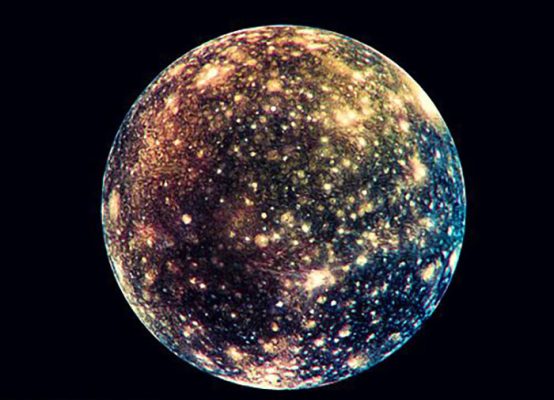

Callisto is one of the big moons in the Jupiter’s circuit. This moon has an ancient surface full of collisions that indicate that there are no geological processes; But the moon has an underground ocean, and because of its old surface, the existence of life in this ocean is still certain.
Like the other four moons, Callisto was discovered in the year 9. The name of this moon was initially Jupiter IV, But in the nineteenth century, it was called Callisto . Callisto was investigated by numerous probes, including the long-term mission of the Galileo spacecraft in the 1980s and decades. The Juno spacecraft has also recorded remote images of Callisto . Callisto is a Jupiter with its host -packed 5.5 billion years. This moon is the heaviest mass of the collision cavity in the entire solar system, But its level has remained intact for about 5 billion years ago.
Among Galileo’s moons, Callisto is the foremost moon. The moon is about one million eight hundred and eighty thousand kilometres from the Jupiter. It takes almost seven days to complete the Jupiter’s Callisto . Callisto has fewer tidal effects than other Galileo moons; Because across the belt is the main radiation of the Jupiter. Callisto has a tidal lock to the Jupiter and is always on one side of the Jupiter.
Callisto , with a diameter of 2 kilometres, is almost the same as the planet Mercury. This moon is the third largest moon in the solar system after Ganim and Titan (Saturn’s moon). The month is fifth after Io. The temperature of the Callisto level reaches -1.5 degrees Celsius. The Galileo spacecraft sent detailed information about Calisto in Year 2. In this mission, much of the moon was mapped, and its thin carbon dioxide atmosphere and evidence of the underground ocean were discovered. According to the images obtained from the Hubble Space Telescope in Year 2, Callisto’s effect on the clerical climate explosions was revealed. Their Jupiter has the aurora, But some of the Jupiter’s aurora phenomena stem from its interaction with its four large moons.
Future missions, including Juice, dedicated to the study of Jupiters’ ice moons, will reveal more facts about Calisto and the possibility of life. Articles have also been published on the modelling of the Jupiter’s and Callisto magnetic field interaction (this review provides evidence of the Callisto subsurface ocean) and the finding of atomic oxygen in the atmosphere. Other articles focus on dimensions such as the water below the surface, the number of collision openings and atmospheric characteristics.
Ganymede


Ganymede is the largest Jupiter’s moon and the largest moon in the solar system. This moon is even larger than Mercury and Pluto, and slightly smaller than Mars; As a result, if it were in the orbit of the sun, it would easily have been in the category of planets. ganymede is likely to have a saltwater ocean beneath its icy surface; As a result, it becomes one of the strong candidates for life discoveries. ganymede is one of the goals of the Juice mission that will be launched in the 1980s.
Callisto, Ganymede and europa have a saline underground ocean
Ganymede, like Callisto and Io, is a Jupiter’s age at the age of 1.5 billion years. The moon is more than one million and seventy thousand kilometres from the Jupiter and completes the planet’s orbit within seven days. The average radius of ganymede is 1.5 km. ganymede is larger than Mercury but its mass is half the mass of Mercury and therefore has little density. The average temperature of the day at the Ganymede level reaches a negative of 2 to 2 degrees Celsius. Astronomers with the Hubble Telescope, in the year 6, obtained evidence from the Oxygen Ganymede Joe. However, this atmosphere is too thin to support the vital we know, and it is unlikely that living things will be able to settle on ganymede.
Ganymede only has a magnetosphere in the entire solar system. The magnet, commonly found on planets such as Jupiter and Earth, is a sequel in which pregnant particles are trapped and deviated. ganymede magnetism is embedded in the Jupiter’s magnetism. Galileo changed its name to Jupiter III after discovering ganymede. With the increase in the number of objects discovered in the mid -19th century, the name of the moon was renamed Genmod according to Greek myths.
Ganymede Features: Ganymede has an iron core, a stone mantle and a high thick shell, most of which are ice. There are also traces of stone formation on the ganymede surface. On February 4, NASA unveiled a precise map of ganymede in the form of video images and animation created using NASA’s Voyager 1 and 2 spacecraft as well as the Galileo Circuit.
The Ganymede surface consists of two types of main surfaces: approximately 2 % of the dark ganmod surface with multiple collision openings and 2 % is light-coloured with grooves that give Ganymede a special look. The grooves are caused by tectonic activities or the spread of water below the surface.
According to scientists, Ganymede has an underground saline ocean. Scientists, using the Hubble Space Telescope, examined the Aurora and the changes between the Jupiter’s magnetic fields and ganymede. According to the evidence of these aurorae, Ganymede probably has a saline underground ocean that is even saltier than the oceans of the earth.
Some scientists have pointed to the possibility of life in ganymede. Due to the internal structure of ganymede, the pressure of the ocean floor is so high that any water that reaches it becomes ice. For this reason, hot water flows can hardly bring nutrients to the oceans.
Europa
Europa is Galileo’s smallest moon. The surface of this frozen moon and covered with a layer of ice; But to scientists, there is an ocean beneath this ice surface. The ice surface has made europa one of the most reflective moons of the solar system.
Researchers, using the Hubble Space Telescope, identified signs of waterfalls from the South europaan region in year 6. After numerous efforts, the research team saw the waterfalls in years 1 and 2. europaan moon was formed about 1.5 billion years ago with its host planet, the Jupiter. On average, europa’s distance from the Jupiter is 1,800 kilometres. It takes three and a half days for europa to complete the Jupiter orbit. europa has a tidal lock to the Jupiter; So there is always one side to the Jupiter.
Europa is 5 kilometres in diameter than the moon and larger than Pluto. The europaan surface temperature at the equator is never above 2 degrees Celsius and at the poles of this moon is no more than 2 degrees Celsius. Galileo discovered europa on January 2. Of course, it had observed it a day ago on January 6; But he could not distinguish this moon from Iowa. In Greek myths, Greece is stolen by Zeus (Jupiter’s counterpart, the Roman God) and becomes a white cow to seduce europa. He brings the cow with flowers and sends it to the city of Crete. Zeus returns to their normal way in Crete and seduces europa. europa was a queen of Crete and gave birth to several children for Zeus.
One of the prominent features of europa is the high reflection capability due to the icy shell. According to scientists, europa’s level is 2 to 5 million years old. Galileo’s spacecraft images and data show that europa has a combination of silicate stone, iron core and stone mantle just like Earth. Unlike the interior of the Earth, the europaan stone space is surrounded by a layer of water or ice that reaches 1 to 2 kilometres. According to europaan magnetic field fluctuations, there is probably an ocean below the surface of the moon that can host life. The possibility of europaan extraterrestrial life has made it an attractive destination for space exploration.
The europaan level is full of fractures and gaps. According to many scientists, these gaps are the result of the tidal forces of the ocean below the europaan level. When europa approaches the Jupiter, the sea level under the ice reaches above normal. In these conditions, the continuous tidal of the sea causes gaps in the surface of the moon. In year 2, scientists realized that europa could host tectonic pages. In the solar system, only the earth has a variable shell that is useful for the evolution of life on earth.
Life in europa: The presence of water under the frozen shell has made europa the moon one of the potential candidates for hosting life in the solar system. The Deep Ice of the moon probably has channels to the mantle like the ground. These channels provide the warm environment needed to evolve life. According to a study in Year 2, europa’s oxygen was estimated at ten times its hydrogen, which is similar to Earth’s. Thus, the ocean below the europaan level becomes a better environment for life.


Jupiter loops
Jupiter’s rings are made of dust and stone and are divided into three sections of aura, the main ring and the thin ring. Jupiter’s rings were discovered by the Vaviger probe. The combination of Jupiter rings is different from Saturn’s rings made of ice. Jupiter’s rings are very dim and delicate.
- Internal: The internal part of the Jupiter’s rings made of dust surrounds the space on the planet. This is the brightest and thickest part of the Jupiter’s rings.
- The main ring section: The main part of the ring is the thinnest part and consists of dust and stone. The dust particles in this section date back to 5 years or even 5 years. This means that it is caused by the collision with larger rocks of the new dust.
- Gossamer: Gosmer is the outside of the Jupiter’s rings. This section is, like the previous two parts, a combination of dust particles; But the word gossamer means a narrow material that is suitable for this part because of its very small dust particles.
Jupiter’s rings are not shining like Saturn’s because they are composed of particles and dust, and only the strongest telescopes can observe them. Jupiter’s moons are the cause of the rings of this planet. The most internal moons, such as the Metis, Adrastea, and Amalthea, were hit by many meteors, and their dust and rock particles reached the Jupiter’s orbit, thus forming the rings of the planet.
Wonders of Jupiter Planet
Jupiter planet has many wonders because of its strong attraction and magnetic field as well as its strange moons. Here are some examples of these wonders:
The influence of the Jupiter on the solar system: The Jupiter is also famous for the vacuum cleaner of the solar system for its severe attraction and internal position of the solar system. The planet experiences the most collision with comets among the planets of the solar system and is thought to act as a shield for the internal planets of the solar system.
If the sequel to Shoemaker–Levy 2 was hit by the earth, there would be no trace of life on earth
But according to recent computer simulations, the Jupiter has not had a significant role in reducing the bombing of the internal planets of the solar system, although the debate is still going on. At least it can be said that it has rescued internal planets from a disaster called Shoemaker–Levy. Schmidker Levi 3 has experienced one of the most exciting ends. Shoemaker–Levy’s treatment of the Jupiter caused injuries to the surface of the planet that are even visible from Earth. This is the first accident in the two internal crimes of the solar system, and the traces of this comet on the Jupiter’s atmosphere are far beyond expectation.
Shoemaker–Levy comet encountered the Jupiter in year 6, and this encounter had a great deal of fear in public opinion because if a similar comet had hit Earth, life would be destroyed on the planet.
Two Armageddon films were inspired by the confrontation and were made on the subject of land-threatening objects. Congress, after the release of these films, called for NASA to search for objects close to Earth. Schumacher Levi was first discovered in March by three comets from Eugene and Caroline Shoemaker and David Levy. The group had previously collaborated and discovered other comets. For this reason, the name Schumicar Levi was chosen for this comet.
The comet was rotating around the Jupiter decades ago but was not in the trap of a strong attraction. The orbital calculations showed more that this comet had treated the Jupiter in July. At that time, the Galileo spacecraft was still on the path of the planet and could not record a close view of the collision.
Strange Aurora: This year, the Juno probe discovered a new aurora that fluctuates on the Jupiter’s poles. Juno’s UVSA (UVS) tool recorded this bright phenomenon. This aurora extends in the form of high-speed rings between 1.2 and 2.5 km / s. According to scientists, these aurorae have been created due to pregnant particles from the edge of the massive Jupiter’s magnetosphere. Jupiter Aurora, like the earth, depends on the pregnant magnet particles. However, the Jupiter’s magneto science is 5 times stronger than the Earth’s magnetism.
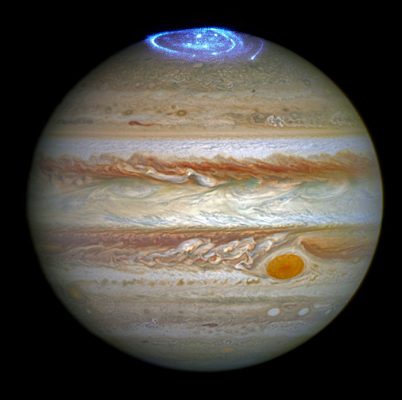

New Facts of Hot Jupiter Dots: A generation after the discovery of the hot and dense atmosphere in the Jupiter, Juno’s mission came to newer answers to these points. Juno discovered hot spots that were much wider and deeper than past models and observations. The results were announced on December 5 at the annual conference of the US Geophysics Union.
More water discovery in Jupiter’s atmosphere: According to Juno probe data in year 2, approximately 2.5 % of the Jupiter’s equator molecules are water molecules. However, this does not appear to be three times higher than that of the solar water molecules based on the calculations of the components of the water, hydrogen and oxygen in the Jupiter. Juno’s measurements discovered more water than previous missions. This discovery can help scientists in search of the real Jupiter origin.
The similarity of Jupiter Wajar Clouds to Earth Clouds: Jupiter and Earth may seem like two completely different planets, but the atmosphere of the two planets is more like each other. The Juno probe captured images of small-scale wave patterns in the Jupiter’s atmosphere during the year. These images, captured by the Junocam tool, reveal the similarity of these cloud shapes to the earth. These waves in the Earth’s atmosphere are called meniscus or medium scale. Now the same waves have been discovered in the Jupiter’s atmosphere called atmospheric wave strands.


Seeing the Jupiter Planet from Earth
Jupiter is the fourth bright object in the night sky (after the sun, moon and venom). The close to Jupiter’s position varies from the sun and the earth. The mean range of the planet’s vision is 1.5 % and its standard deviation is 1.2.
Since the Jupiter’s orbit is out of the ground, the phase angle of the planet from Earth is never more than 1.5 degrees. For this reason, the planet is always seen from telescopes based on Earth. With a small telescope, even Galileo’s moon and cloud belts around the Jupiter can be observed.
Preturecopian Research
Jupiter observation dates back to Babylonian astronomers in the seventh or eighth centuries BC. Chinese astronomers also observed the Jupiter’s orbit and built the ground-branch cycle based on their approximate years.
Telescopic research based on Earth
In January, Galileo Galileo examined the planet’s Jupiter with its small telescope. His observations changed the current understanding of the universe. Galileo saw three small stars near the Jupiter. The next afternoon he was able to see the stars again, but this time they were on the other side of the planet. During a few weeks, these stars were moving around the Jupiter. Galileo gave the names of the stars of Medici to their supporters, but today they are known as Galileo’s moons.
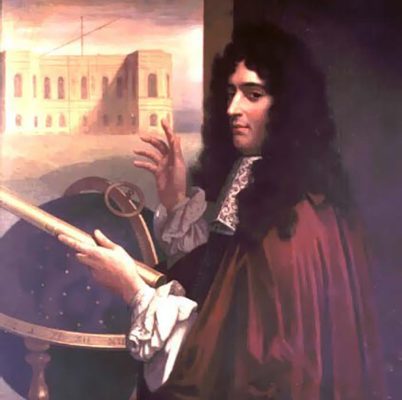

This was the first telescopic observation of the solar system (other than the moon). The day after Galileo Simon Marinus independently discovered the moons around the Jupiter but did not publish the results of his discoveries until year 6. This discovery was a turning point in the Copernican Central Sun theory of the movement of planets. Galileo was questioned for supporting this theory for insulting the sacred.
In the 1980s, Juvan Cassini used a new telescope to discover colourful tapes and Jupiter stains and was able to estimate the rotation period of the planet. Cassini discovered the difference between the rotation of the Jupiter’s atmosphere with the planet itself. The large red spot in the southern hemisphere of the Jupiter was probably monitored by Robert Hook and at Cassini at 2, though there is still debate. Astronomy named Henry Schwab released the first design of the Great Red Spot details at 2.
Borley and Cassini both made detailed tables of Jupiters’ lunar movements and predicted the movements of these moons. At 2, Bernard discovered the fifth Jupiter at the California Observatory. The discovery of this relatively small object made him famous. This is called the Mohammed. It was the last planet’s moon that was discovered directly with an eye observatory.
At 1, Robert Wildt discovered the immense methane tapes. Three rotating rings (large-scale wind rotation around a high-pressure central point unlike clockwise) called white rings were also discovered. Finally, two rings were merged in 2, and the third ring known as BA was absorbed in 2
Radiottic research
Based on radio signals, Bernard Burke and Kent Franklin were able to discover explosions of 1.2 MHz. The explosions were consistent with the rotation of the planet, and they used this information to correct the rotation ratio. Jupiter radio explosions have two major forms: Long explosions (L explosions) last for a few seconds and short explosions (S) last less than one hundred seconds.
Jupiter probes
Eight spacecraft and probes have so far examined the planet: Pioneer 10 and 11, Voyager 1 and 2, Galileo, Cassini, Yolis, New Horizons and Juno.
Pioneer 10 and 11 (Pioneer)
Pioneer 1 and 2 were the first spacecraft to review the Jupiter. The two probes recorded the first scientific observations from the planets Jupiter and Saturn and paved the way for Voyager’s missions. The external tools of these ships examined the climate of the Jupiter and Saturn, the magnetic fields, the moons and the rings, as well as the intermediate dust and magnetic areas, solar winds and cosmic rays. The two probes left the Solar System on their way.
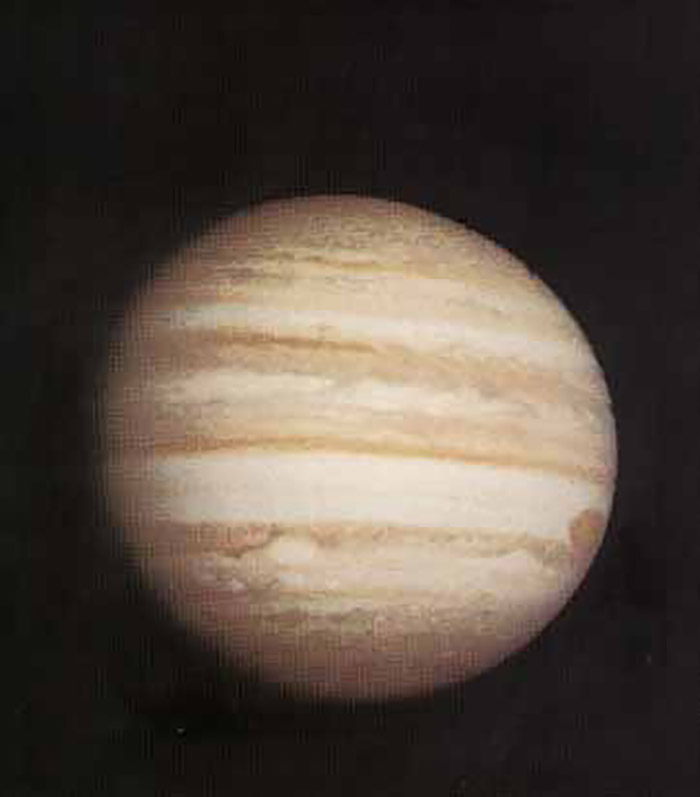

Voyager 1 and 2 (Voyager)
NASA sent two Voyager spacecraft to the Jupiter, Saturn, Uranus and Neptune in late summer. The nearest Voyager 2 contact with the Jupiter is registered on March 5. The closest gap between Voyager 2 to the planet was recorded on July 5.
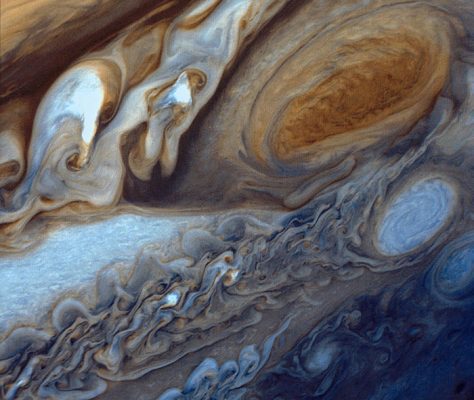

Jupiter photography began in January. Wower 2 completed his mission for the Jupiter in early April, after registering 4.3 images and many other scientific measurements. The Voyager mission was from late April to early August. The two spacecraft recorded more than 1.5 % of the Jupiter and five moon images. Voyager 1 and 2 provided a lot of information on moons, magnetic fields and more to researchers. The biggest achievement of the two spacecraft was the discovery of volcanoes active on the moon.
Galileo spacecraft (Galileo Spacecraft)
The Galileo spacecraft was launched on October 5 with the Atlantis Space Shuttle missile and reached the Jupiter on 2. The probe has been in the Jupiter’s circuit for almost eight years and examined its moon. Based on the information obtained from the camera and the other four tools of the probe, the possibility of the ocean under the europaan moon was investigated. According to the discoveries, the volcanoes of the moon are very active. Another discovery of Galileo was ganymede’s separate magnetic field. Galileo was carrying a small probe that was sent deep into the Jupiter’s atmosphere and was destroyed about an hour later due to too much pressure.
Cassini spacecraft (Cassini)
Cassini was a cooperation between NASA and the europaan Space Agency (ESA) and the Italian Space Agency, and its main purpose was to investigate Saturn, the system and moons of the planet. The probe was at the closest distance to the Jupiter on December 5 and recorded numerous scientific measurements. Cassini recorded 6,000 images of the planet, rings and moon during six months of flight around the Jupiter. Cassini’s biggest achievement for the Jupiter was the most accurate colour portrait of the planet (until then).
Other Cassini observations include the dark cloud of the spinning at the top of the Jupiter’s atmosphere, almost the size of a large red spot, near the North Pole. Based on the evidence that Cassini obtained from the Jupiter’s rings, the loop is composed of an irregular structure that is probably due to the collapse of the stone from the Metis and Adrastea moons.
Ulysses’ spacecraft (Ulysses)
Ulysses was the result of NASA’s cooperation and the europaan Space Agency launched in October, with the main purpose of examining the space zone above the sun’s poles. Since Ulysses needed a lot of energy to put it in the sun’s orbit and the earth could not provide it, it was necessary to supply this space from another planet. The Jupiter was the nearest planet that could provide the prerequisites for the trip.
Ulysses reached the Jupiter six months after his departure from Earth, and on February 4, he was closest to the planet. Although the secondary goal of Ulysses was to investigate the Jupiter, in this short trip he was able to find very useful information about the very strong magnetic field of the planet.
New Horizons spacecraft
New Hurazenz was a mid-range probe built at the Johns Hopkins University Physical Laboratory (APL) and the Southwest Research Institute (SWRI) and was launched into space in year 6 to investigate Pluto. New Hurazenz used Jupiter attraction (2 times the gravity of the Earth) to be on the Pluto route.
New Hurahiznes used the Lorri tool to capture its images of the Jupiter on September 9, from 2 million kilometres. More careful Jupiter reviews continued in January with the capture of the infrared image of Calisto’s moon and a few blacksopoid images of the Jupiter itself.
One of the main goals of this probe was to examine the weather conditions and analyze the structure of Jupiter clouds. The probe for the first time was able to capture the Jupiter’s small red spots from the distance. He also succeeded in capturing images of the planet’s circular system from different angles. New Hurahizenz moved to the Jupiter’s magnetosphere with valuable information about it.
Juno spacecraft (Juno)
NASA’s Space Explorer Juno was launched on August 1 and entered the Jupiter’s orbit on July 5 to begin careful scientific investigations. The spacecraft has been rotated 2 times around the Jupiter so far and has been over the clouds of clouds for approximately one year.
The purpose of the Juno mission is to measure the composition, the gravity field, the magnetic field and the polar magnetosphere of the planet. It also looks at clues to the formation of the planet, the stone kernel, the amount of water in the atmosphere, the distribution of its crime, and its deep winds, reaching a speed of 3 km / h.
Unlike other exploratory sent to the solar system planets, Juno is reinforced with solar arrays similar to that of the ground satellites, while their isotopic thermoelectric generators are usually used inside the Solar System.
During the Juno mission, infrared tools and microwaves measured heat radiation from the Jupiter’s atmosphere. These are supplements for previous studies of the planet’s composition of abundance and distribution of water and oxygen. Data provide new views on Jupiter origin.
Juno has also found unprecedented findings about Jupiters’ atmospheric winds. According to these findings, the planet’s atmospheric winds last longer than the atmospheric processes on Earth. Juno’s measurements from Jupiter Square Square prove the asymmetry of the north and south of the planet, which is similar to the asymmetry observed in the belts and tapes of the planet. The deeper the winds, the more mass increases.
According to another Juno finding, the climate of the planet is a rigid body. This is a wonderful result, and Juno’s future measurements help to understand this transition from the air to the rigid body. Before Juno’s discovery, there was no information about the atmosphere close to the client poles. According to the information obtained from this probe, the Jupiter poles are more violent than the white and orange belts located in the lower latitudes of the planet.
The north pole of the planet is surrounded by a central tornado, surrounded by eight tornadoes with variable diameters from 1 to 2.5 km. Jupiter Antarctica also has a central tornado with five more tornadoes with variable diameters from 1 to 2 kilometres. The Juno spacecraft is currently reviewing the planet’s orbit, sending amazing images, atmospheric data and other observations about the planet.
James Web Telescope images from Jupiter
The James Webb Space Telescope, which has been working since last year, has had significant observations in recent months. One of these remarkable observations is accurate images of the Jupiter’s planet and its polar Aurora. Both images of the telescope are a combination of several images made with a camera near the NIRCAM camera with different filters.
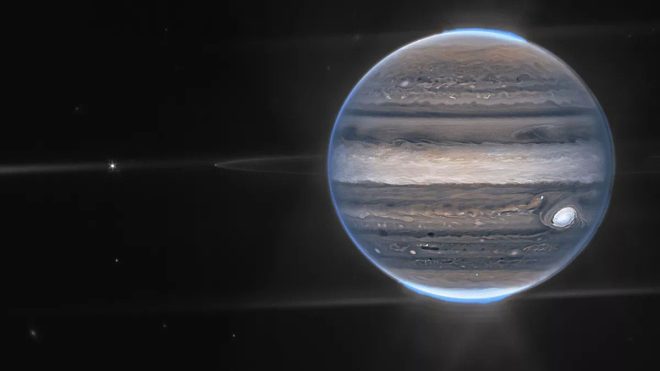

In the wider image, you can see the narrow rings of the Jupiter as well as the two moons. Almatia’s moon is a bright spot on the left and Adracetia’s moon is on the edge of the rings between Alamalea and the Jupiter. The second image is recorded from a close-up of the Jupiter’s planet. This image uses three filters to record details of the planet’s stormy atmosphere, especially the polar Aurora. You might think about why the colours of these images are not like what we see in other Jupiter images.
Read more: Meerkat telescope a new tool to observe extraterrasial signals
In these images, the James Web Telescope records light in the infrared spectrum, not the visible light spectrum; So the colours of the two images are not the same as the unarmed eye colours. The infrared data were written on the visible light spectrum, so these images are “false colour”, not “real colour”.


Future missions to the Jupiter
Juice (Jupiter Ice Coordinator): Juice is a europaan Space Agency’s mission, which has been selected as part of the Cosmic Vision Scientific Program. The probe is expected to be launched in year 6 and reaches the Jupiter after visits to the interior of the solar system in the 1980s. The probe is dedicated to studying Galileo’s ice moons: ganymede, Calisto and europa. All three moons have subsurface oceans, which increases their potential for life.
europa Clipper: The NASA europaan probe is dedicated to europa’s review of the Jupiter’s ice moon and will examine the living conditions under the ice shell. The probe will be in the Jupiter’s orbit for accurate europa. The europaan probe will be launched in the early 1980s and will reach the Jupiter’s planet after a 6.5 -year trip.
Chinese and Russian missions: China will launch its first Jupiter probe in year 6. The probe will reach the Jupiter planet in year 6. Russia is also looking to send a survey to the Jupiter that will be launched in year 6. It takes 6 months and first visits the moon and Venus. He then examines the Jupiter and its moons.


You may like
Space
How to prevent the earth from being baked by the scorching sun?
Published
11 hours agoon
05/05/2024

How to prevent the earth from being baked by the scorching sun?
One day, the sun will enter a stage where life on Earth will no longer be possible and our planet will simply turn into a mass of iron and nickel. The good news is that if we do our best, we can keep our home livable even after the sun gets too hot.
Waking nightmare
The Sun will gradually become brutally brighter, hotter, and larger over time. Billions of years ago, the Sun was 20 percent dimmer than it is today when a series of molecules danced together to form living things. At that time, even the dinosaurs faced a fainter and smaller star.
Today, the sun is halfway through its hydrogen life and is still 4 billion years away from entering the death phase. However, in the next few hundred million years, the temperature and brightness that is giving life to our planet today will lead to its destruction. A few hundred million years is like a blink of an eye on a cosmic scale.
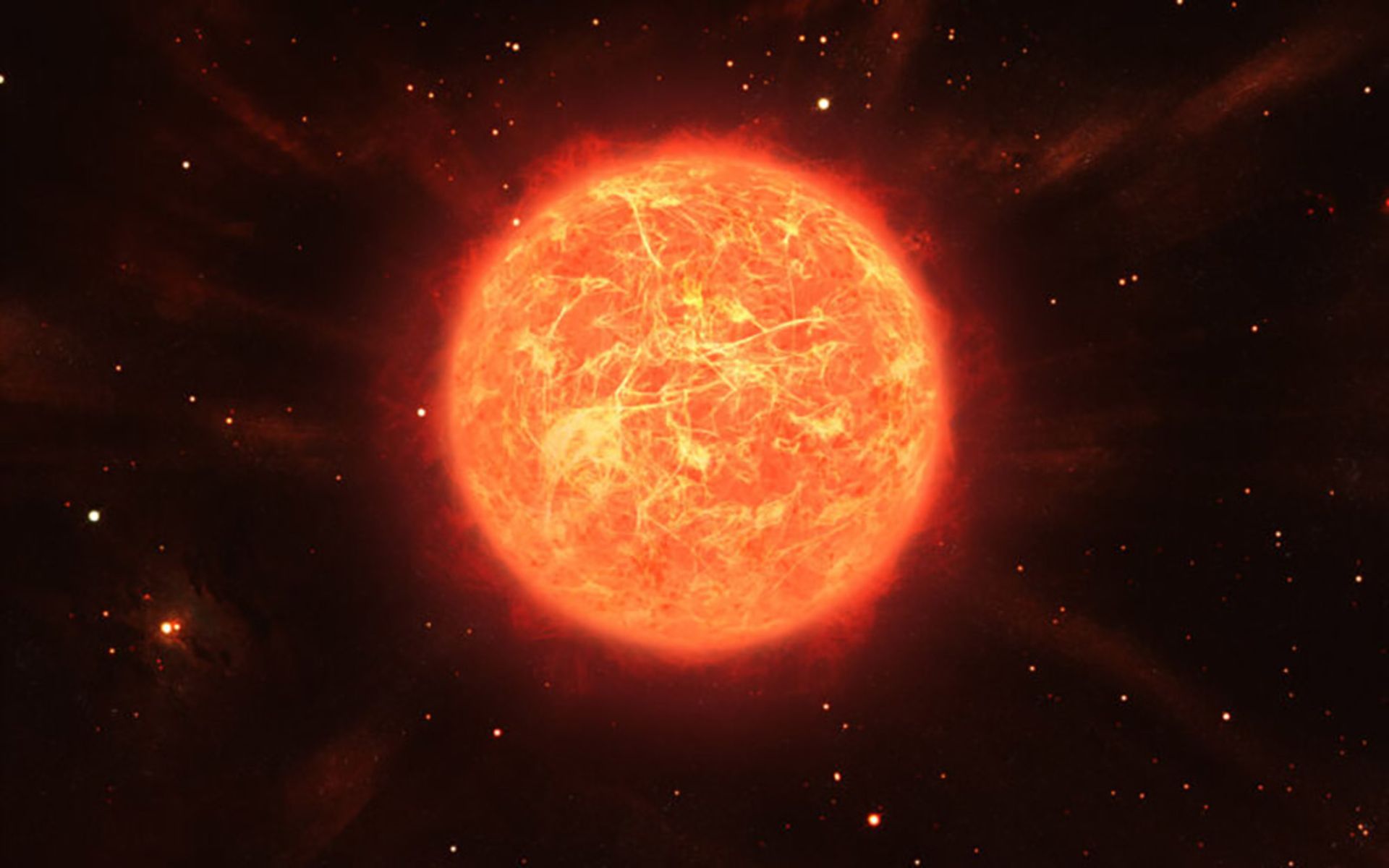 The sun is getting bigger and brighter day by day.
The sun is getting bigger and brighter day by day.
The sun sows the seeds of its destruction based on its fundamental physical properties. In the current conditions, our star consumes 600 million tons of hydrogen every second; So the atoms collide with each other in a nuclear inferno with a temperature of more than 15 million degrees Celsius. Of these 600 million tons, 4 million tons of hydrogen are converted into energy, which is enough to light up the entire solar system.
The fusion reaction is not completely clean and the resulting product is helium. Helium has nowhere to go because the deep convective cycles that continuously churn up the material inside the Sun do not reach the core, where helium is formed; Therefore, helium remains there in an unused, motionless, and stagnant form.
The sun consumes 600 million tons of hydrogen every second
At the present time, the Sun has not reached the high temperature and pressure in its core for helium fusion; So the helium stays there, increasing the overall mass of the nucleus without giving it anything else to fuse with. Fortunately, the sun can compensate for this process through hydrostatic balance.
The Sun is in constant equilibrium on the edge of a nuclear knife. On the one hand, energy is released from the fusion process, which, if left unchecked, can cause the sun to explode or at least expand. In front of this force, there is the gravitational weight of the sun, which exerts an inward force. If this force is released, the sun’s gravity will cause it to collapse and turn it into a black hole the size of an average city.
So what happens when an unstoppable force meets an irresistible force? A pleasant balance is established and the sun can continue to exist for billions of years. If for any reason the temperature of the inner nuclear inferno increases randomly, other parts of the star will also heat up and its outer layers will swell. In this way, the gravitational pressure decreases and the nuclear reactions slow down. If the Sun randomly contracts, more material will force itself into the core, where it will participate in the nuclear dance. The energy released as a result of this event causes the star to re-inflate to normal proportions.
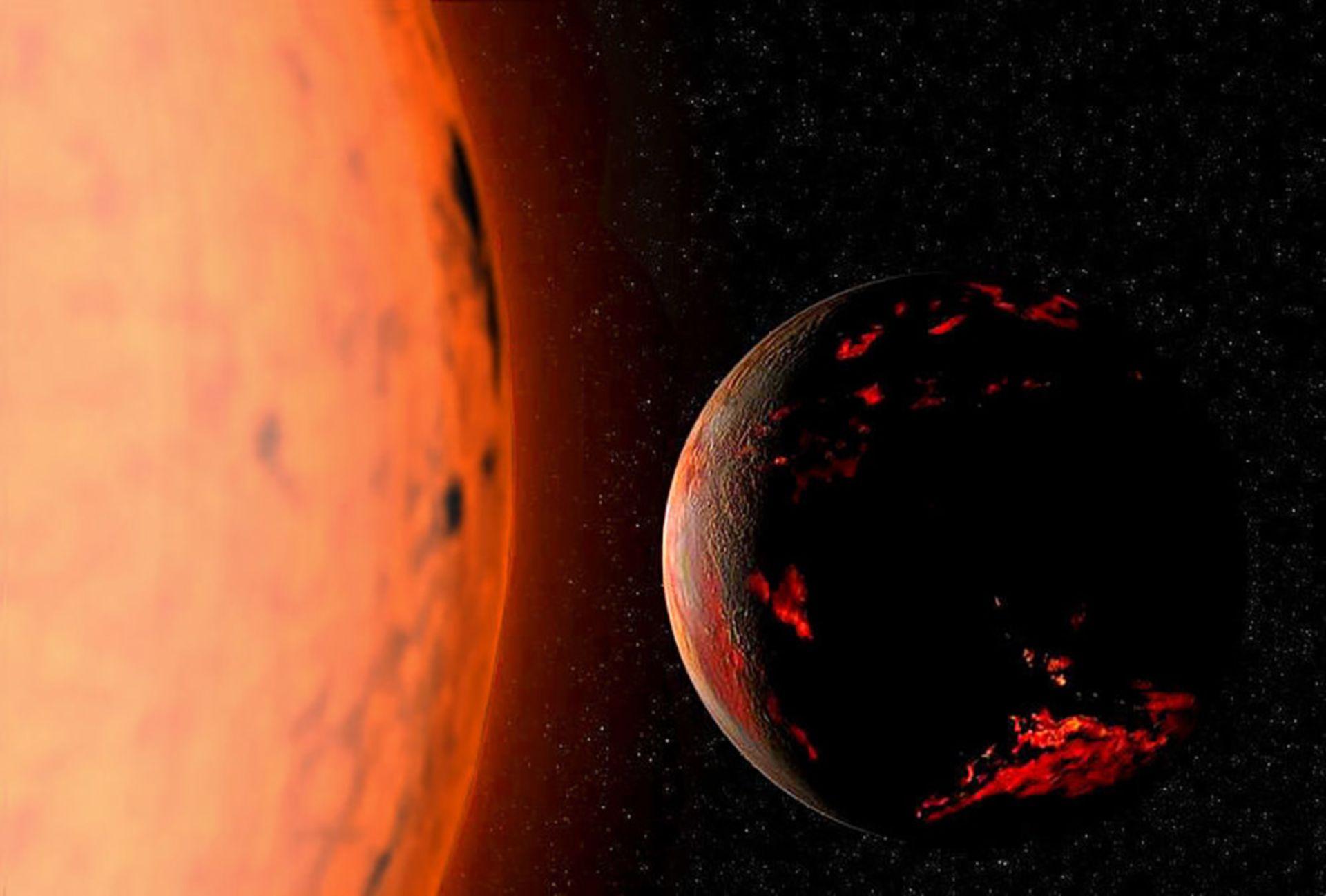 The sun will destroy the earth before it dies.
The sun will destroy the earth before it dies.
On the other hand, helium, which is a nuclear product, replaces hydrogen and disturbs the balance. In this state, the sun has no choice but to pull internally, because gravity is unyielding. Meanwhile, nuclear reactions intensify and increase the temperature, which eventually causes the sun’s surface to glow and expand.
Slowly, as helium continues to accumulate in the core of the Sun, or any star of similar mass, the Sun grows larger and brighter in response to this process. It is difficult to predict exactly when this glow will become catastrophic for the Earth, this issue is strongly related to the relationship between the rays, the atmosphere, and the ocean; But the general estimate is that we have about 500 million years before life on Earth becomes impossible.
The burning sun will increase the temperature of the earth’s surface. It evaporates at higher ocean temperatures. Since water vapor is an important greenhouse gas, a large part of it remaining in the Earth’s atmosphere leads to higher surface temperatures. Higher temperatures lead to more evaporation of the oceans, setting the stage for the greenhouse cycle. Finally, we will witness the escape of a large part of the earth’s waters into the atmosphere.
Without water to lubricate tectonic activity, tectonic plates stop moving. Without tectonic activity to pull carbon out of Earth’s atmosphere, the planet’s air density would increase dramatically. As a result, in a few hundred million years, we will become Venus, the twin planet of Earth, which experienced the same fate billions of years ago; Two dead worlds in the hands of their parent star.
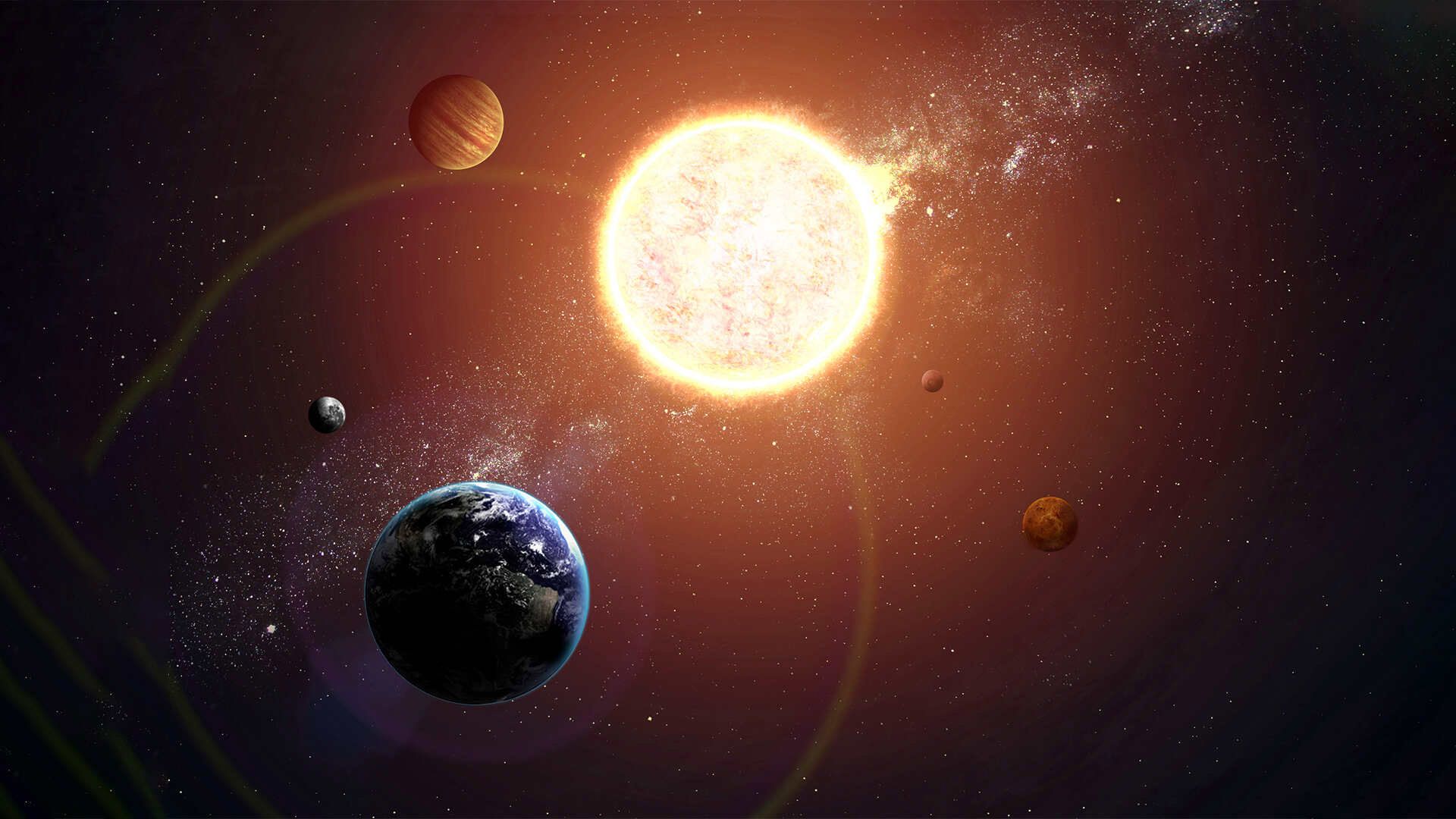 By shifting the earth’s orbit, it can be saved from the sun.
By shifting the earth’s orbit, it can be saved from the sun.
Change the position of the planet
The habitable zone is the region around a star where the temperature is suitable for the flow of liquid water on the surface of a planet. Temperatures near the star are too high to prevent any atmospheric complexity so that water exists only as vapor. Outside this range, the temperature is very low.
Earth is now roughly in the middle of the Sun’s life belt, Venus is on the inner edge, and Mars is almost outside. As the age of the sun increases and its brightness increases, the life belt will reach more distant parts of the solar system; So if we want the Earth to survive this process, we have to move it.
Moving a planet will not be an easy task; But fortunately, we are dealing with vast astronomical time scales and we don’t need to move the earth today. In fact, we have hundreds of millions of years to plan this transition. To do this, we can use the same stabilizing force that keeps the planets in orbit around the sun, and that force is nothing but gravity.
The first thing we need to do is find an energy source. Raising the earth’s orbit requires a lot of energy, and this energy has to be supplied from somewhere. Fortunately, we can use the planet Jupiter. Since this gaseous world is 318 times heavier than Earth, its simple movement through the sky provides a surprising amount of kinetic energy, and a small amount can be borrowed.
We are almost 500 million years away from the destruction of the earth by the sun
Jupiter’s energy can be transferred to Earth through orbital interactions. To better understand this issue, suppose you are standing inside a wheeled platform on a railway track and a train is moving towards you. You can’t step out of the way of a train (because then the analogy wouldn’t be fun); So your only chance to survive is to move at least as fast as the train. Of course, if you simply let the train hit the counter, then your speed will match the speed of the train, but not in the way you’d expect.
Instead, you can reach into your pocket and pull out a bouncing meatball. Suppose, this ball is durable and indestructible. You throw the ball at the train. The ball hits the train and bounces back. Then you grab it and move forward a bit. With just a little practice, and through simple conservation of momentum, you’ll find that you can steal some of the train’s energy and give it to yourself and the rolling platform. The train barely notices these collisions, but you do. If you get enough power you can move on without facing disaster.
Now let’s return to the example of Earth and Jupiter. The above analogy is suitable for preventing Jupiter from colliding with our planet, except we use asteroids instead of bouncing balls. We can send asteroids on long orbits around Jupiter. In this scenario, the gravitational interaction between the planet Jupiter and the asteroid leads to an increase in the speed of the asteroid and, in turn, a slight decrease in the speed of the giant Jupiter. Then we can bring the asteroid back to Earth, rotate it in the opposite direction, and achieve the desired force by slowing down its motion.
Running the above process once doesn’t have much effect; So we have to repeat it for hundreds of millions of years so that the Earth can reach higher orbits and thus escape from the wrath of the sun. If our descendants can control this process, they can move the Earth into a safe zone of the habitable zone.
 The Sun loses mass through the solar wind or particle stream.
The Sun loses mass through the solar wind or particle stream.
Star setting
If you are not interested in changing the arrangement of the planets, but have the ability for super-engineering projects, we have another solution for you. The main problem with the sun is that helium is a natural product of our star’s fusion process. The hydrogen fusion ratio is defined based on the total mass of the Sun; The bigger a star is, the faster it burns, and in the same way, smaller stars burn at a slower rate; Therefore, if we want to limit the amount of helium production, we must slow down the fusion reactions. The easiest way is to reduce the total mass of the Sun.
Fortunately, the sun is naturally decelerating, but not fast enough. The surface of the Sun continuously emits an endless stream of tiny charged particles, which we call the solar wind. In terms of human-scale statistics, the amount of mass that the Sun loses through the solar wind is 1 to 2 million tons per second, which is an incredibly high rate; But this speed should be increased a little.
The Sun loses one to two million tons of mass every second through the solar wind
One way to speed up the mass loss of the Sun is to heat its surface with lasers or special rays, strong magnetic fields, or whatever mechanism our descendants choose. Heating the surface of the sun leads to an increase in the production of solar winds, and thus the speed of the sun’s mass loss increases; But high-energy particles that are released at high speed are not suitable for habitability on Earth, so they must be transported to a safe place.
One way to control the solar wind is to build a series of particle accelerator stations in orbit around the Sun’s equator. These stations continuously exchange charged particles and create a loop of current in the shape of the solar belt. This current loop creates a torus (donut-shaped) magnetic field that can transform the solar wind into polar outflows in the direction of the sun’s rotation axis and safely remove harmful particles from our planet.
The torus magnetic field can be used to compress the star. According to this method, first, the stations are turned off and thus the particles fall into the sun. Then, by turning on the stations, the magnetic field is interrupted and the falling process is reversed. The magnetic field surrounding the sun’s equator is compressed, forcing particles to be repelled from the sun’s poles.
If our descendants are advanced, they can capture the elusive solar wind and use it for other purposes, such as fusion reactor systems to power an entire facility, and if they are creative, they can direct the outflow of the solar wind in one direction and use it as a booster rocket. use solar to guide the solar system to new points in the Milky Way or even outside the galaxy.
Of course, the technique of moving the star reduces the brightness of the sun; Because despite the lower mass, the fusion reactions take place in a quieter atmosphere, which reduces the power and dimensions of our star. In this way, the life belt moves to an inner part. We may not realize this at first, because the things we do are in opposition to the natural tendency of the life belt to move outward; But eventually, after the Sun has lost 10-20% of its mass, we have to move the Earth to the inner part of the life belt to keep it in the right spot.
In the end, we are left with a smaller, long-lived star. The smallest red dwarfs with a mass of a little more than one-tenth of the Sun can live for trillions of years; But at the same time, it has a more chaotic nature, because due to their low mass, they are subject to stellar explosions that periodically double their brightness. If our descendants want to take this path to increase the life of the sun, they must definitely prevent these explosions.
All in all, if humanity can survive for billions of years, it will probably become an interplanetary or interstellar entity. In this situation, there will be no need to save the land. Perhaps our distant descendants can preserve the land from which they sprang as a mark of respect. Perhaps this is necessary because no other world is as suitable for life as Earth. Ultimately, perhaps, it is an art project, an opportunity to create beauty and wonder on an interplanetary scale, before the fires of nuclear fusion die out and our star breathes its last. The last chapter of the story ends the billions of years of life of the solar system.
Space
James Webb space telescope map of the climate of an exoplanet
Published
3 days agoon
02/05/2024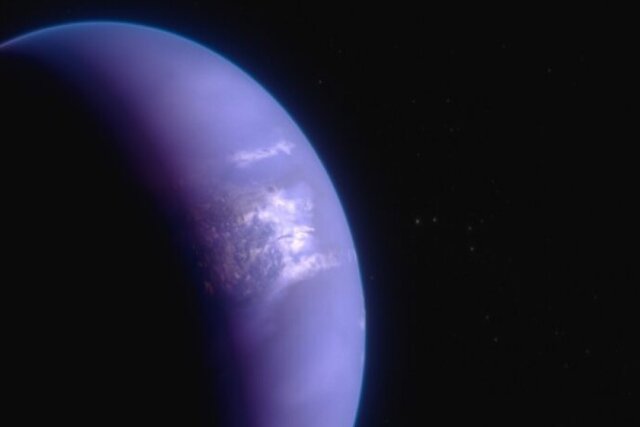

The James Webb Space Telescope helped researchers map the climate of an exoplanet.
James Webb space telescope map of the climate of an exoplanet
An international team of researchers has successfully used the James Webb Space Telescope to map the climate of a hot gas giant exoplanet.
According to NASA, detailed observations in a wide range of mid-infrared light, along with 3D weather models and previous observations from other telescopes, show the presence of dense, high clouds that cover the sky during the day and night, as well as show tropical winds. They say they are merging atmospheric gases at 5,000 miles per hour around the exoplanet WASP-43 b.
This is the latest demonstration of exoplanet science, now made possible by James Webb’s extraordinary ability to probe temperature changes and detect atmospheric gases trillions of miles away.
The exoplanet WASP-43 b is a type of “Hot Jupiter”. This Jupiter-sized planet is made mostly of hydrogen and helium and is much hotter than the other giant planets in the solar system. Although its star is smaller and cooler than the Sun, WASP-43 b orbits at a distance of 1.3 million miles, less than one-twenty-fifth the distance between Mercury and the Sun.
With such an orbit, the planet is tidally locked; This means that one side is constantly lit and the other side is in permanent darkness. Although the night side never receives any direct radiation from the star, strong eastward winds carry heat from the day side around.
Since the discovery of the planet WASP-43 b in 2011, it has been observed by several telescopes, including the Hubble Space Telescope and the Spitzer Space Telescope. “With the Hubble Space Telescope, we can clearly see that there is water vapor on the day side of the planet,” said Bay Area Environmental Research Institute (BAERI) researcher Taylor Bell. Both Hubble and Spitzer showed that clouds may exist on the night side, but we needed more detailed surveys with the James Webb Space Telescope to begin mapping temperatures, cloud cover, winds, and atmospheric composition more precisely across the planet.
Although WASP-43 b is too small, faint, and too close to its star to be seen directly by a telescope, the planet’s short orbital period of just 19.5 hours makes it ideal for “phase curve spectroscopy.” The phase curve spectroscopic method involves examining small changes in the brightness of a star-planet system as the planet orbits the star.
Because the amount of mid-infrared light emitted by a body depends largely on how hot it is, James Webb’s brightness data can be used to calculate a planet’s temperature.
For more than 24 hours, the research team used James Webb’s Mid-Infrared Instrument (MIRI) to measure the light of the WASP-43 system every 10 seconds. “By observing an entire orbit, we were able to calculate the temperature of different sides of the planet as it rotated into view,” Bell explained. Based on these calculations, we were able to create a map of the temperature of the entire planet.
Measurements show that the air temperature on the day side of the planet is close to 1250 degrees Celsius on average; While the temperature of the night side reaches 600 degrees Celsius and is significantly cooler. These data help locate the hottest spot on the planet, which is slightly eastward from the point receiving the most stellar radiation. This change occurs due to the blowing of winds that move the warm air towards the east.
“Michael Roman” (University of Leicester) researcher and one of the researchers of this project said: “The fact that we can map the temperature in this way is a real proof of James Webb’s sensitivity and stability.”
To interpret the map, the researchers used complex 3D atmospheric models, similar to those used to understand weather and climate on Earth. Analyzes show that the night side of the planet is probably covered in a dense and high layer of clouds, and this layer prevents part of the infrared light from reaching space. As a result, although the night side is very warm, it appears dimmer and cooler than when there are no clouds.
The broad spectrum of mid-infrared light taken by James Webb makes it possible to measure the amount of water vapor and methane around the planet. “Joanna Barstow”, a researcher at “The Open University of UK” and one of the researchers of this project, said: “James Webb has given us the opportunity to find out exactly which molecules we see and put limits on their abundance.”
The observed light spectra show clear signatures of water vapor on the planet’s nightside and dayside, providing additional information about the density of clouds and their height in the atmosphere.
Read more: The highest observatory in the world officially started its work
Also, the researchers were surprised to find that the data showed a lack of methane everywhere in the atmosphere. Because the day is too hot for methane to exist, methane should be cooler, stable, and detectable at night.
“The fact that we don’t see methane tells us that the wind speed on WASP-43 b must be about 5,000 miles per hour,” Barstow explained. If the winds move the gas from the day side to the night side of the planet and back again quickly, there won’t be enough time for the chemical reactions to produce detectable amounts of methane on the night side.
Researchers believe that because of this wind-driven mixing, the chemistry of the atmosphere is the same across the planet. This result was not clear in previous researches that were conducted with Hubble and Spitzer telescopes.
This research was published in “Nature Astronomy” magazine.
Space
The highest observatory in the world officially started its work
Published
4 days agoon
01/05/2024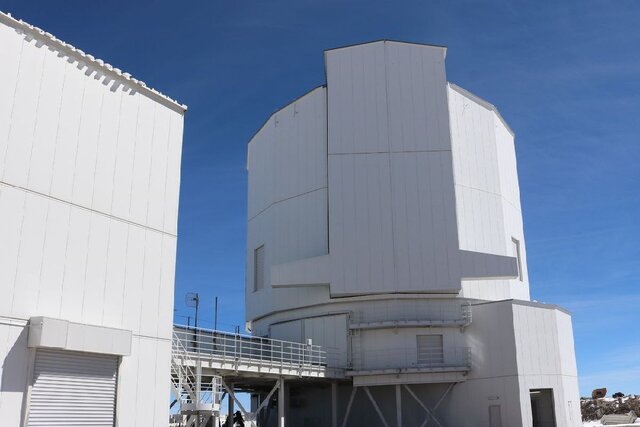

The Tokyo Atacama University Observatory, which has the title of the highest observatory in the world, is now ready for work.
The highest observatory in the world officially started its work
A new telescope, which is introduced as the highest observatory in the world, has been officially opened.
Tokyo Atacama University Observatory (TAO), which was first designed 26 years ago to study the evolution of galaxies and exoplanets, is located on top of a high mountain in the Chilean Andes at an altitude of 5,640 meters above sea level. . The height of this telescope even exceeds the “Atacama Large Millimeter Array” (ALMA), which is located at an altitude of 5050 meters.
The TAO observatory is located in a region where the high altitude, sparse atmosphere, and perpetually dry weather are deadly for humans, but it is an excellent spot for infrared telescopes like TAO because their observational accuracy relies on low humidity levels that keep the Earth’s atmosphere at wavelengths. Infrared makes it transparent.
Yuzuru Yoshii, a professor at the University of Tokyo (UTokyo), said: “Building a telescope on the top of the mountain was an incredible challenge, not only from a technical point of view but also from a political point of view.” I communicated with the indigenous people to ensure their rights and views were taken into account, with the Chilean government to obtain permits, with local universities for technical cooperation, and even with the Chilean Ministry of Health to ensure that people could climb safely at that altitude. to work
He added: The research that I have always dreamed of doing, thanks to everyone involved, will soon become a reality and I could not be happier.
The 6.5-meter TAO telescope has two science instruments designed to observe the world in infrared light. One such instrument, called SWIMS, will image galaxies in the early universe to understand how they formed from the merger of dust and pristine gas. Despite decades of research, the details of this process remain obscure. The second device, MIMIZUKU, will contribute to the mission’s overall goal by studying the primordial dust disks from which stars and galaxies formed.
Riko Senoo, a student at the University of Tokyo and a researcher on the TAO project, said: “The better astronomical observations of the real object, the more accurately we can reproduce what we see with our experiments on Earth.”
Masahiro Konishi, a researcher at the University of Tokyo, said: “I hope that the next generation of astronomers will use TAO and other ground-based and space-based telescopes to make unexpected discoveries that challenge our current understanding and provide the unexplained.”
Read more: Why there is no gaseous moon in solar system?
Before the newly opened telescope was built, Yoshi and his colleagues in 2009 also assembled a 1-meter telescope on top of Mt. This small telescope called “miniTAO” imaged the center of the Milky Way galaxy. Two years later, miniTAO received the Guinness World Record for being the highest astronomical observatory on Earth.
Although the observatory has been the talk of the town for the past 26 years, work on its construction site began in 2006. At that time, the first road to reach the summit was paved, and shortly after, a weather monitoring system was installed there.


How to prevent the earth from being baked by the scorching sun?


James Webb space telescope map of the climate of an exoplanet


The highest observatory in the world officially started its work


Many mental disorders have physical roots


How to connect to the TV with a Samsung phone?


The secret of the cleanest air on earth has been discovered


Asus Zenbook 14 OLED laptop review


How extinct animals could be brought back from death?


Xiaomi Pad 6S Pro review


Testing a vaccine that reduces liver tumors
Popular
-



 Technology9 months ago
Technology9 months agoWho has checked our Whatsapp profile viewed my Whatsapp August 2023
-



 Technology10 months ago
Technology10 months agoHow to use ChatGPT on Android and iOS
-



 Technology9 months ago
Technology9 months agoSecond WhatsApp , how to install and download dual WhatsApp August 2023
-



 Technology11 months ago
Technology11 months agoThe best Android tablets 2023, buying guide
-



 Humans1 year ago
Humans1 year agoCell Rover analyzes the inside of cells without destroying them
-



 AI1 year ago
AI1 year agoUber replaces human drivers with robots
-



 Technology10 months ago
Technology10 months agoThe best photography cameras 2023, buying guide and price
-



 Technology11 months ago
Technology11 months agoHow to prevent automatic download of applications on Samsung phones

